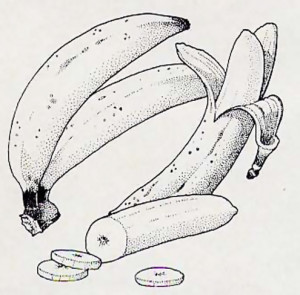The Last Word in Health Food
Far above the fray of contending nutrionists, devotees simply eat food offered to Krsna and enjoy physical and spiritual health.
by Visakha-devi dasi
While researching for this feature, I consistently find that nutritionists clash on all fronts. “Cow’s milk is not suitable for human consumption… Milk causes constipation, biliousness, coated tongue, headache… :” “As a daily guide, adults should take two or more glasses of fresh milk …”
“Saturated fatty acids are not needed in the diet at all.” “A rational fat consumption … balances saturated and unsaturated fats … .” “The vitamins and minerals contained in natural foods are much more usable than those derived from other sources.” “The body cannot distinguish in any way between a vitamin from a plant or animal and the same vitamin from a laboratory.”
And on it goes. But for most of us it really doesn’t mater that the experts disagree , since we have only a hazy and haphazard interest in the nutritional value of the food we eat, anyway. Generally we eat what we like to eat, we eat what we’ve always eaten, and we eat what’s available without too much trouble. And, provided we’re fairly healthy, we don’t concern ourselves about it much more than that.
There’s a minority, however, that is concerned—about pesticides and chemical additives, about high calorie and cholesterol counts, and about food industries that create their products with high profit margins in mind rather than health and nutrition.
Devotees of Lord Krishna stand worlds apart from both groups: those who choose their food by habit, and the conscientious health and diet fans. Srila Prabhupada asks, “By whom are you being taught what is healthy and what is not healthy? What is you authority? Actually this ‘healthy’ and ‘unhealthy’ is a material consideration. We are simply interested in what Krishna wants. So we offer Him whatever He wants to eat. And He asks for food prepared from grains, milk and milk products, vegetables, and fruits.” A nondevotee eats what he deems tasty or healthy. But what is tasty for one is unpalatable for another, and what is healthy for one is poison for another.
A devotee doesn’t hover in this way, on the sensual and mental platforms. He eats only what’s been offered to Krsna, and he offers Krsna only what Krsna likes. And by the Lord’s arrangement, the staple foods He likes make a perfectly nourishing and balanced diet. For example, on an average day a devotee might breakfast on fruit, hot milk or yogurt, cereal, a little ginger root, and some chickpeas. For lunch: rice, dal (bean soup), capatis (unleavened bread), and vegetables. And in the evening: fruit, hot milk, and a light snack. Now, if you were to analyze this diet for its nutritional content (which we can’t do here for lack of space), you’d find it has all the protein, carbohydrates, vitamins, fiber, fat, and minerals you need for good health. You’d find that it has enough calories to maintain your weight, but not so many as to give you unwanted and unsightly bulges. You’d find it low in cholesterol, as well as sugar and salt. You’d find it economical, tasty, and full of variety. (For example, there are fifty common vegetables you can combine with milk products, grains, spices, and herbs, and then bake, steam, saute or fry. The range of flavor, texture, aroma, and color is astonishing.) To put it simply, you would find the devotee’s daily diet ideal by modern standards of nutrition, economics, and eating pleasure. And because it’s been formulated by the ideal person, Lord Krsna, and the dishes have been offered to Him, you’d also find that it helps you advance spiritually.
A devotee doesn’t offer Krsna food cooked by someone who’s materially motivated, who’s in it for the money. The proper mood in cooking for Krsna is one of gratitude and love: “My Lord has kindly provided these ingredients, so let me combine them and cook them in such a way that He will be pleased.” Thus in one easy step the devotee is saved from all the health hazards and empty calories that accompany processed, precooked junk food.
In the past few months we’ve presented recipes for rices, dal soups, whole-wheat bread, and vegetables. And in the near future we’ll be presenting elegant side dishes—homemade snacks, savories, and desserts—that are ideal for special days and special guests. You’ll find Krsna conscious dishes to fit any occasion, any mood, any time, and any person—dishes that can fully satisfy a child or a connoisseur, a nutritionist or a fast-food addict, a dieter or a football fullback. All you need to make these dishes are a few simple ingredients and a little practice. By preparing and offering these wholesome foods, we step beyond the world of mundane wrangling, of charts and percentages and profit motives, and quietly enter another world—a world where Krsna stands supreme, where He enjoys our cooking and offering and appreciates our love and devotion. And in this world, unlike ours, there is no disease, no old age, and no death. What could be healthier?
(Recipes by Yamuna-devi dasi)
In the Vedic tradition, raita is a name given to a wide range of raw or semicooked fruit and vegetable salads. These simple, easy-to-prepare salads provide a light, cooling contrast to the elaborately seasoned, cooked preparations of the luncheon or evening meal. A raita generally features one or two main ingredients that float in lightly seasoned, creamy fresh yogurt. Serve raitas in small bowls, allowing ½ cup per serving.
Chopped Spinach in Yogurt
Chopped spinach is marbled in yogurt to form this colorful, delicious raita.
Preparation time: 20 minutes
Servings: 5 or 6
¾ pound fresh spinach
1 ½ cups natural yogurt (or 1 ¼ cups yogurt and ¼ cup cream)
1 teaspoon cumin seeds
1/8 teaspoon Kashmiri cumin seeds, if available
1 teaspoon salt
1/3 teaspoon freshly ground black pepper
1. Wash the spinach; sort out and remove the thick stems. Steam the leaves on a metal rack above boiling water for ten to twelve minutes. Remove, cool slightly, press out the water, and chop very finely.
2. Heat the cumin seeds and Kashmiri cumin seeds (if available) in a dry, heavy iron pan over a low flame, tossing and roasting for approximately 5 minutes or until lightly browned. Remove and crush to a coarse powder. Add the salt and pepper.
3. Whisk the yogurt in a medium-size bowl until creamy. Add all the ingredients and mix well before offering to Krsna.
Sliced Bananas in Creamy Yogurt
(Kela Raita)
With a hint of heat from fresh green chilis and a hint of sweet from ripe bananas, this raita has an intriguing combination of textures, colors, and flavors.
Preparation time: 10 minutes
Servings: 4 or 5
1 ¼ cups natural yogurt
¾ teaspoon salt
2 smallish, firm ripe bananas, peeled and cut diagonally to make slices ‘/8 inch thick
1 ½ tablespoons vegetable oil or ghee (clarified butter)
¼ to 1 small hot green chili, seeded and cut into paper-thin julienne strips
1 teaspoon black mustard seeds
2 tablespoons finely chopped fresh mint leaves
1. Whisk the yogurt, salt, and finely chopped mint leaves in a small bowl and then fold in the sliced bananas.
2. Heat the ghee or vegetable oil in a small saucepan over a medium flame until it is hot. (A drop of water flicked into it should sputter instantly.) Add the mustard seeds. When they pop and crackle, remove the pan from the heat. Toss in the strips of green chili, swirl and tilt the pan, and then pour the seasoning into the yogurt. Blend well and then cover.
3. Refrigerate for at least one hour before offering to Krsna.
Carrots, Cashews, and Dates in Yogurt
(Gajar-Kaju Raita)
This colorful, naturally sweet raita is healthful and pleasing when a cool dish is required. Adjust the amount of sweetener according to the tartness of the fresh yogurt.
Preparation time: 10 minutes
Servings: 5 or 6
2 medium-size sweet carrots, peeled and shredded
5 pitted dates, sliced into thin round pieces
¼ cup chopped cashew nuts, dry-roasted or fried
1/8 teaspoon freshly ground nutmeg
2 tablespoons honey
1 ¼ cups natural yogurt
1. Remove all excess water from the shredded carrots by pressing handfuls between your palms.
2. Combine all the ingredients in a 1-quart bowl and blend well. Refrigerate for about one hour before offering to Krsna.
Sliced Cucumbers and Tomato Cubes In Yogurt (Kakri Raita)
Preparation time: 10 minutes
Servings: 5 or 6
1 medium-size cucumber
2 teaspoons salt
1 medium-size, firm ripe tomato, cut into ‘/2-inch cubes
2 tablespoons finely chopped fresh coriander or parsley leaves
¼ teaspoon freshly ground black pepper
¼ teaspoon garam masala, if available (try an Indian grocery)
1 teaspoon cumin seeds
1 ¼ cups natural yogurt
1 tablespoon sliced almonds
1 tablespoon currants
1. Dry roast the cumin seeds and crush them coarsely. Whisk the yogurt.
2. Peel the cucumbers, quarter them lengthwise, cut out the seeds, and slice thinly crosswise. Sprinkle the slices with 1 teaspoon salt, mix well, and set aside for 6 to 10 minutes. Then gently squeeze the cucumbers between your palms to remove excess liquid.
3. Combine the tomatoes, cucumbers, black pepper, garam masala, and roasted cumin seeds in a bowl. Pour in the yogurt and salt and gently blend. Pour into individual serving dishes or a serving bowl and sprinkle the surface with almonds and currants. Offer to Krsna immediately, or chill if desired.



Leave a Reply